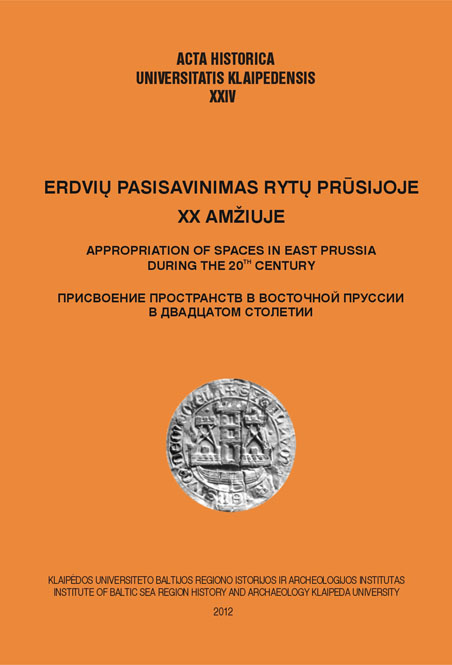Volume 24 (2012): Erdvių pasisavinimas Rytų Prūsijoje XX amžiuje = Appropriation of Spaces in East Prussia during the 20th Century = Prisvoenie prostranstv v Vostochnoi Prussii v dvadtsatom stoletii, June 2012

Order by:
Pub. online: 5 Jun 2012
Type: Introduction
 Open Access
Open Access
Journal:
Acta Historica Universitatis Klaipedensis
Volume 24 (2012): Erdvių pasisavinimas Rytų Prūsijoje XX amžiuje = Appropriation of Spaces in East Prussia during the 20th Century = Prisvoenie prostranstv v Vostochnoi Prussii v dvadtsatom stoletii, pp. 6–22
Pub. online: 5 Jun 2012
Type: Article
 Open Access
Open Access
Journal:
Acta Historica Universitatis Klaipedensis
Volume 24 (2012): Erdvių pasisavinimas Rytų Prūsijoje XX amžiuje = Appropriation of Spaces in East Prussia during the 20th Century = Prisvoenie prostranstv v Vostochnoi Prussii v dvadtsatom stoletii, pp. 23–50
Abstract
Pub. online: 5 Jun 2012
Type: Article
 Open Access
Open Access
Journal:
Acta Historica Universitatis Klaipedensis
Volume 24 (2012): Erdvių pasisavinimas Rytų Prūsijoje XX amžiuje = Appropriation of Spaces in East Prussia during the 20th Century = Prisvoenie prostranstv v Vostochnoi Prussii v dvadtsatom stoletii, pp. 51–66
Abstract
Pub. online: 5 Jun 2012
Type: Article
 Open Access
Open Access
Journal:
Acta Historica Universitatis Klaipedensis
Volume 24 (2012): Erdvių pasisavinimas Rytų Prūsijoje XX amžiuje = Appropriation of Spaces in East Prussia during the 20th Century = Prisvoenie prostranstv v Vostochnoi Prussii v dvadtsatom stoletii, pp. 67–77
Abstract
Pub. online: 5 Jun 2012
Type: Article
 Open Access
Open Access
Journal:
Acta Historica Universitatis Klaipedensis
Volume 24 (2012): Erdvių pasisavinimas Rytų Prūsijoje XX amžiuje = Appropriation of Spaces in East Prussia during the 20th Century = Prisvoenie prostranstv v Vostochnoi Prussii v dvadtsatom stoletii, pp. 78–91
Abstract
Pub. online: 5 Jun 2012
Type: Article
 Open Access
Open Access
Journal:
Acta Historica Universitatis Klaipedensis
Volume 24 (2012): Erdvių pasisavinimas Rytų Prūsijoje XX amžiuje = Appropriation of Spaces in East Prussia during the 20th Century = Prisvoenie prostranstv v Vostochnoi Prussii v dvadtsatom stoletii, pp. 92–118
Abstract
Pub. online: 5 Jun 2012
Type: Article
 Open Access
Open Access
Journal:
Acta Historica Universitatis Klaipedensis
Volume 24 (2012): Erdvių pasisavinimas Rytų Prūsijoje XX amžiuje = Appropriation of Spaces in East Prussia during the 20th Century = Prisvoenie prostranstv v Vostochnoi Prussii v dvadtsatom stoletii, pp. 119–140
Abstract
Pub. online: 5 Jun 2012
Type: Article
 Open Access
Open Access
Journal:
Acta Historica Universitatis Klaipedensis
Volume 24 (2012): Erdvių pasisavinimas Rytų Prūsijoje XX amžiuje = Appropriation of Spaces in East Prussia during the 20th Century = Prisvoenie prostranstv v Vostochnoi Prussii v dvadtsatom stoletii, pp. 141–152
Abstract
Pub. online: 5 Jun 2012
Type: Article
 Open Access
Open Access
Journal:
Acta Historica Universitatis Klaipedensis
Volume 24 (2012): Erdvių pasisavinimas Rytų Prūsijoje XX amžiuje = Appropriation of Spaces in East Prussia during the 20th Century = Prisvoenie prostranstv v Vostochnoi Prussii v dvadtsatom stoletii, pp. 153–171
Abstract
Pub. online: 5 Jun 2012
Type: Article
 Open Access
Open Access
Journal:
Acta Historica Universitatis Klaipedensis
Volume 24 (2012): Erdvių pasisavinimas Rytų Prūsijoje XX amžiuje = Appropriation of Spaces in East Prussia during the 20th Century = Prisvoenie prostranstv v Vostochnoi Prussii v dvadtsatom stoletii, pp. 172–187
Abstract